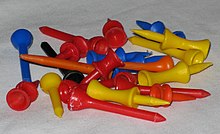Tee (golf)
A tee [ tiː ] in golf , also called golf tee , is a small stick made of wood or plastic or a combination of both materials that is stuck into the ground when teeing off and on which the ball can then be placed (tied). The ball is thus elevated and is easier to play. The ball may only be teened on the first stroke of each fairway. The tee-off location itself, the rectangular and mostly raised lawn at the beginning of each fairway, is also called the tee.
A normal tea is 2 1/8 inches (about 5.4 cm) long. The maximum length is limited to 4 inches (10.16 cm). Oversized tees are particularly popular for teeing off with the driver (wood 1). Flat winter teas made of plastic are used in the cold season, as normal teas can no longer be stuck in the hard ground.
history
The introduction of the tee was the last major change to the rules of golf before 2019. Before this change, the ball was placed on a small pile of sand. For this purpose, boxes filled with sand were provided at each tee. This explains the name "tee box" which is still used today for the tee area.
The first patented tea dates back to 1892. The tea was called “Perfectum” and was an iron stopper with a rubber ring topped with a head made of upright rubber pins.
Since that time there have been many inventions and innovations, none of which have been able to assert themselves in the long term. The classic tee used by most golfers is still a nail-like stick made of wood. Only teas made of plastic have achieved some popularity for reasons of durability, but are not welcomed on golf courses due to their poor environmental compatibility . As a compromise between shelf life and environmental compatibility, biodegradable teas, for example made from pressed wheat or biodegradable plastics , are now available.
In 2004 tees that indicate the line of play or affect the movement of the ball were banned.
literature
- Irwin R. Valenta: Singular History of the Golf Tee . Greensboro 1995.
Web links
Individual evidence
- ↑ history of golf tees. golfsportmagazin.de, accessed on January 31, 2020 .
